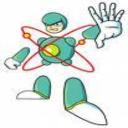Yahoo Answers is shutting down on May 4th, 2021 (Eastern Time) and beginning April 20th, 2021 (Eastern Time) the Yahoo Answers website will be in read-only mode. There will be no changes to other Yahoo properties or services, or your Yahoo account. You can find more information about the Yahoo Answers shutdown and how to download your data on this help page.
Trending News
If car crashes, coming to a complete stop, how fast will an object fly out of the car?
In a completely theoretical environment, lets say a 1000 kg car is moving at 40 km/hr with a board on the top of the car weighing 10 kg. If the car crashes, coming to a complete stop, how fast does the board fly off the car? I initially thought obviously 40 km/hr but the conversation of momentum states-
(m+m2)v=mv+m2v2 which means gives 40400=(1000)(0)+10(v2) which gives us a v2 of 4040 km/hr which is way too fast. What went wrong?
4 Answers
- electron1Lv 76 years ago
In a momentum equation, the velocity must be in m/s. That is one of your mistakes. In the equation that you used, you have the car is colliding with the board. That is why the board’s velocity is so large. In this problem, there is no reason to do a conversation of momentum, because we don’t know the mass of the object that the car collided with. The only way that I can solve this problem is to assume that there is no friction between the board and the roof of the car. As the car’s velocity decreases from 40 km/hr to 0 km/hr, the board will start moving forward. At this moment, the board’s velocity is the same as the car’s velocity. This means the board’s velocity is 40 km/hr. Your initial answer was correct.
- TechnobuffLv 76 years ago
Unimpeded, the board will fly forward at the speed the car was doing before crashing.
It cannot go any faster than the car was going!
Its momentum is (mv) and the car's momentum is (mv), but as the board is not attached to the car, each is independent of the other, but have the same initial V.
- oubaasLv 76 years ago
hahahah miracles do not exist ....Table has its own momentum I = mt*Vt which is conserved , since it can frictionlessly slide away from the stopped car at the same speed it had before impact ...
the table speed in the frame of soil is 40 km/h constant , while the table speed in the frame of car is variable from 0 up to 40 km/h
- ChrisLv 66 years ago
assuming there is nothing to slow it down, the object is going to continue moving at the speed the car was moving at before it stopped...it will change depending on specific information like say you had a box of tissues in the back window of the car...when you stop, the tissues will likely slide and such before finally becoming airborne, the same with virtually any object that is sitting on a surface in your car but different weights and surface areas are going to change how the object acts...




